Introduction
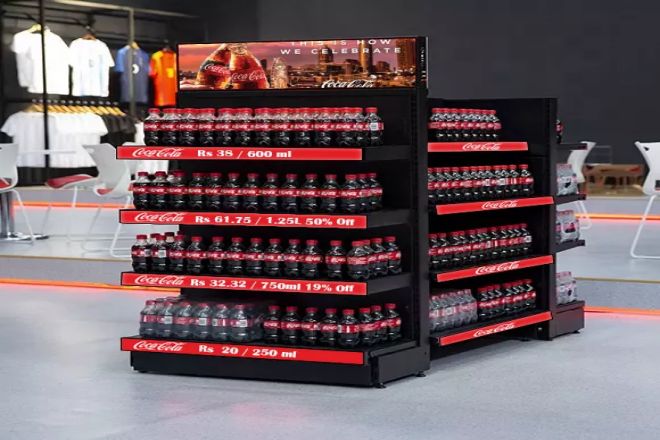
In the fast-paced modern life, the retail environment is constantly evolving, and merchants are constantly seeking new display and promotion methods in order to attract and retain customers. As common display tools in retail environments, shelf screens and traditional shelf labels play different roles.
However, with the advancement of technology and changes in consumer needs, shelf screens have gradually emerged, forming a sharp contrast with traditional signage.
This article will take you through the differences between the two; let’s take a look.
1. Advantages and Disadvantages of LED Shelf Screens
LED shelf screen is a modern retail display tool that combines LED display technology and shelf functions. Its core is a high-definition LED display, which is usually integrated into the panel or side of the shelf and can display various videos, pictures, and text information.
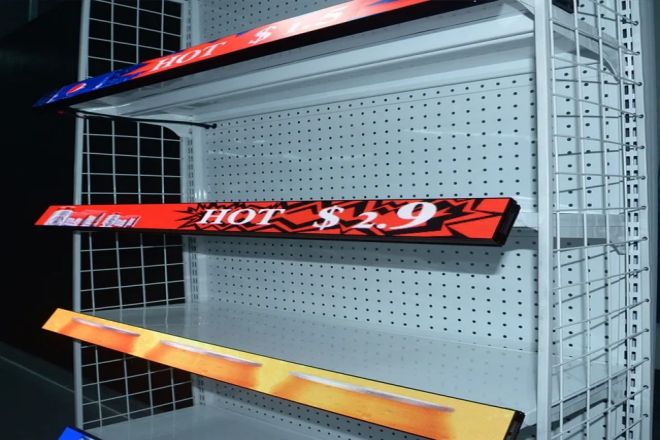
1). Advantages:
High-definition display effect: The LED shelf screen adopts advanced LED display technology, which can present clear and delicate pictures with bright colors and high contrast, bringing high-quality visual enjoyment to consumers.
Dynamic display: Compared with the static display of traditional signs, LED shelf screens can play dynamic videos, pictures, and text, which are more eye-catching, effectively attract consumers’ attention, and increase product exposure.
Strong interactivity: Many LED shelf screens support touch operations. Consumers can check product information, watch videos, participate in interactive games, etc., by touching the screen, which enhances interactivity with products and willingness to purchase.
Personalized customization: LED shelf screens can be personalized according to the needs of different brands and products, including size, shape, color, content, etc. so that the display is more in line with the brand image and market demand.
Versatility: In addition to displaying product information, LED shelf screens can also be used to play advertisements, promotional information, brand promotions, etc., improving the comprehensive utilization of shelves and creating more commercial value for merchants.
Intelligent management: Many LED shelf screens support remote control and management. Merchants can perform content updates, schedule power on and off, perform data analysis, and perform other operations on the shelf screens through the network, which improves management efficiency and convenience.
2). Disadvantages:
Higher Cost: Compared with traditional signs, the manufacturing cost of LED shelf screens is higher, including investment in hardware equipment, software development, content production, etc.
Maintenance cost: Although the LED shelf screen has a long service life, it still requires regular maintenance and upkeep during use, including cleaning the screen, checking hardware equipment, updating software, etc., to ensure its normal operation and extend its service life.
Sensitive to light: In environments with strong or dark light, the display effect of LED shelf screens may be affected, and light conditions need to be reasonably controlled to ensure the best display effect.
Content update frequency: In order to ensure the attractiveness and freshness of the LED shelf screen, the display content needs to be updated regularly. This requires investing certain human and material resources in content production and updating.
Technology dependence: LED shelf screens rely on advanced display technology and electronic equipment. Once a failure or technical problem occurs, it may affect the display effect and the normal operation of the merchant.
2. Advantages and Disadvantages of Traditional Shelf Labels
Traditional shelf labels are a physical medium used to identify and display product information and are usually attached or hung on the product.
They are usually made of paper, plastic, metal, and other materials, with the name, price, brand, production date, and other information of the product printed on them. Traditional product signage plays an important role in the retail environment, helping consumers understand basic information about products and promoting product sales and brand promotion.
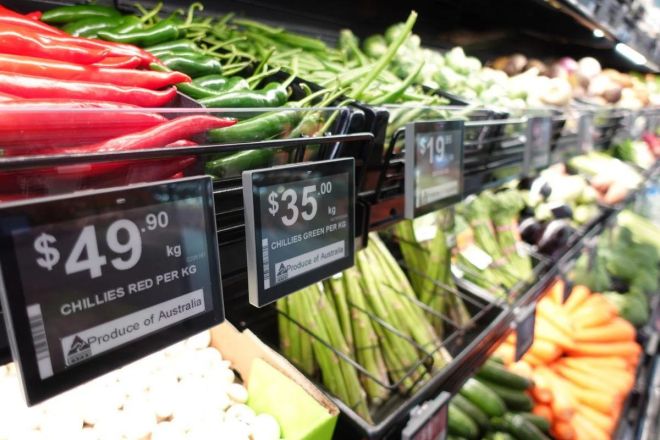
1). Advantage
Intuitiveness: Traditional shelf labels are directly attached or hung on the product, so consumers can see the basic information of the product at a glance without having to search or guess. This direct display method ensures the rapid transmission of information, allowing consumers to quickly understand the key attributes of the product, such as brand, name, price, etc., so as to make purchasing decisions.
Durability: Traditional shelf labels are less susceptible to external factors, such as power outages or network instability. They can display information stably for long periods of time and maintain their functionality even in environments without power or network. This persistence ensures continuous presentation of information and avoids missing or confusing information due to technical glitches.
Low Cost: Compared with electronic display methods, the manufacturing cost of traditional product signs is relatively low. They do not require complex display equipment, software support, or a constant power supply. In addition, large-scale production and application have further reduced unit costs, allowing merchants to purchase and use them more economically.
Flexibility: Traditional shelf labels can be customized for different merchandise and display needs. Merchants can choose the appropriate size, shape, color, and content based on the characteristics of the product, target audience, and brand image to best meet personalized needs. This flexibility allows merchants to create signage that fits their brand image and marketing strategy, making their products more attractive.
2). Disadvantages
Difficulty updating information: Once traditional product signage is produced and attached to the product, it becomes relatively difficult to change the information. If updated information is required, such as price changes or promotions, merchants often need to create new signage and replace the old signage. Not only does this process increase costs, but it may also require additional time and human resources.
Limited information capacity: Due to limitations in physical size and display methods, traditional product signs can only hold a limited amount of information. If the product information is too much or complex, it may not be fully displayed within the limited signage space. This may result in consumers being unable to obtain complete product information, thereby affecting their purchasing decisions.
Lack of interactivity: Traditional shelf labels are usually static and cannot interact with consumers. Consumers cannot obtain more information about the product through touch, click, or other means. This lack of interactivity may limit consumers’ shopping experience and reduce the attractiveness of products.
Limited visual appeal: The visual effects of traditional product signage are relatively limited and may not attract consumers’ attention. In a highly competitive retail environment, if the product’s signage fails to attract consumers’ attention, the exposure of the product may be reduced. This may result in lost sales opportunities and impact the merchant’s business performance.
3. Comparison between LED shelf screens and traditional product signs
1). Visual effects
- LED shelf screen:
LED shelf screen adopts high-definition display technology, with clear and delicate pictures, bright colors, and high contrast. This high-quality display effect makes the products more prominent on the shelves and can quickly attract consumers’ attention. Whether in bright daytime or in a dim indoor environment, LED shelf screens can maintain excellent visual effects.
- Traditional shelf labels:
Traditional product signs are usually made of paper or plastic materials, and the visual effect is relatively simple. They may just be simple words or patterns that lack appeal and appeal. In a competitive retail environment, this traditional signage may struggle to capture consumers’ attention.
2). Information dissemination
- LED shelf screen:
The LED shelf screen can play dynamic videos, pictures, and text, and the information dissemination speed is very fast. Merchants can update prices, promotions, and other information in real time to ensure that consumers can always get the latest product information.
In addition, LED shelf screens also support content display in multiple formats, including dynamic advertisements, product introductions, etc., which can better meet the marketing needs of merchants.
- Traditional shelf labels:
It is relatively difficult to update information on traditional product labels. Once produced and attached to merchandise, changing the message requires creating new signage, which increases Cost and time.
Therefore, merchants may not be able to update price or promotion information in a timely manner, resulting in consumers being unable to obtain the latest product information.
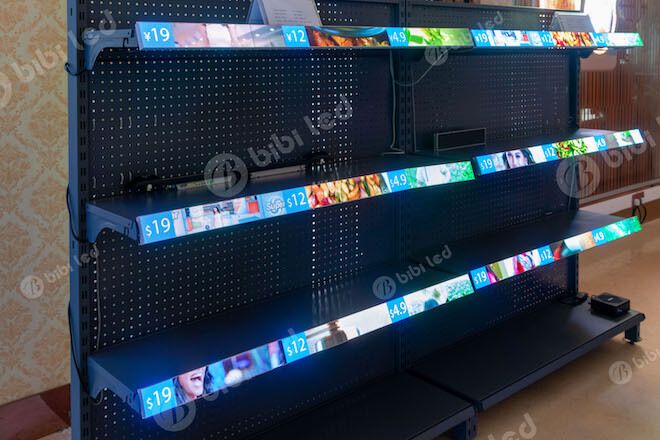
3). Cost
- LED shelf screen:
The initial investment cost of an LED shelf screen is relatively high, including equipment purchase, installation, and debugging. However, after long-term use, the maintenance cost of LED shelf screens is relatively low. Because LED is used as the light source, its power consumption is low, and its life is long, so it can save energy and maintenance costs.
- Traditional shelf labels:
Traditional merchandise signs are relatively low-cost to manufacture. Merchants can use simple paper or plastic materials to make signs without the need for complex display equipment and software support. This makes traditional commodity signage suitable for mass production and application, reducing overall costs.
4). Adaptability
- LED shelf screen:
LED shelf screens are suitable for modern, high-tech retail environments. In modern shopping malls, supermarkets, and other places, LED shelf screens can enhance the overall shopping experience and attract consumers’ attention.
In addition, LED shelf screens also support a variety of display methods and content formats, which can adapt to the display needs of different products and brands.
- Traditional shelf labels:
Traditional merchandise signage is suitable for a variety of retail environments, especially traditional small stores or markets. In these places, traditional product signage may be more in line with consumers’ shopping habits and expectations.
In addition, due to the lower production and replacement costs, traditional product signs are also more suitable for some businesses with limited budgets.
4. How do you choose LED shelf screens and traditional shelf labels
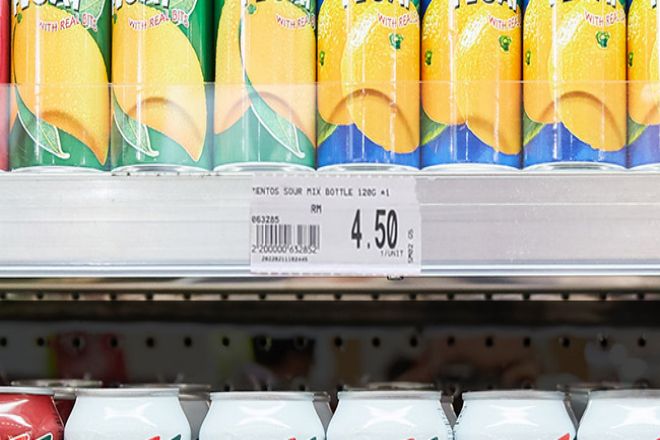
When choosing between LED shelf screens and traditional product signage, you need to consider multiple factors, including budget, display needs, brand image, retail environment, etc. Here are some suggestions to help you make your decision:
- Budget:
First, determine your budget range. The initial investment cost of LED shelf screens is usually high, but the maintenance costs are low after long-term use, while the manufacturing costs of traditional shelf labels are relatively low. Depending on your budget constraints, choose a presentation method that works for you.
- Display requirements:
Consider the type and amount of information you wish to convey to consumers. If you need to display dynamic content, update information in real-time, or provide interactive functions, LED shelf screens may be more suitable for you. And if you only need to display simple product information, traditional shelf labels may be enough to meet your needs.
- Brand:
Consider your brand image and marketing strategy. LED shelf screens can provide more advanced and modern display effects, helping to enhance brand image and attract consumers. Traditional shelf labels may be more suitable for conveying simple, direct brand information.
- Retail environment:
Consider the type and layout of your retail environment. Modern shopping malls, supermarkets, and other places may be more suitable for using LED shelf screens to enhance the overall shopping experience. In traditional small stores or markets, traditional shelf labels may be more in line with consumers’ shopping habits and expectations.
- Maintenance and updates:
Consider ease of maintenance and updates. LED shelf screens may require regular software updates and hardware maintenance, while Traditional shelf labels are relatively simple and only need to be replaced with new signs. Choose the display method that suits you based on your maintenance capabilities and resources.
Conclusion
The above is the entire content of this article. If you want to know more about LED displays, please get in touch with us!
Here’s what you might want to know:
